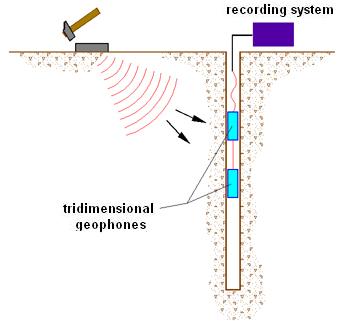The down hole seismic method (DH) measures the time taken for the P and S waves to move between a seismic source located on the surface of the ground, and the receivers, placed inside a borehole (Fig. 1, 2).

Figure 1 - Schematic down hole to a single receiver

Figure 2 - Schematic down hole to two receivers
The components necessary for a accurate DH test consist of :
1.mechanical source capable of generating energy and elastic unidirectional waves ;
2.one or more three-dimensional geophones, with appropriate frequency directional response (4.5 to 14 Hz), having an anchoring system to the walls of the pipe-hole;
3.a multi-channel seismograph, capable of recording in digital mode the wave forms and to record them on mass storage;
4.a transducer (trigger) located in the source, necessary to identify the instant of departure of the dynamic stress using a hammer hitting a steel plate or ball placed on the ground.
During drilling, to reduce the noise effect in the ground, the holes are supported through a benthic mud; their diameter is maintained rather small ( average Ø =15 cm).
The holes are then covered by pipeline, generally PVC, and filled with a shrinkage – controlled mortar, usually composed of water, cement and bentonite respectively at a ratio of 100, 30 and 5 parts by weight.
First of all, it is important to make sure that the hole is free of bottlenecks and the pipe coating does not present cracks.
© GeoStru